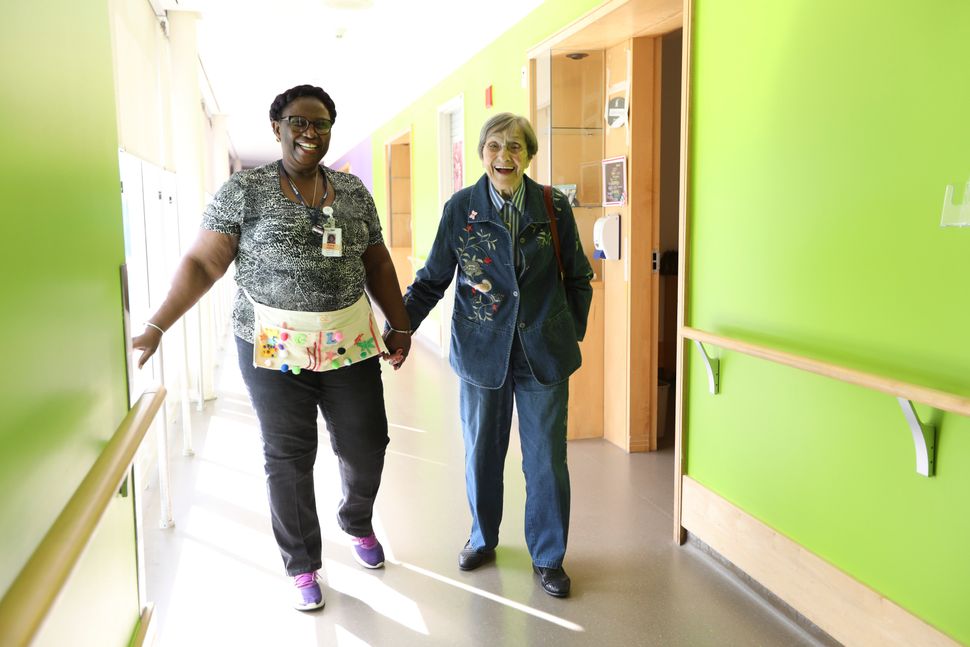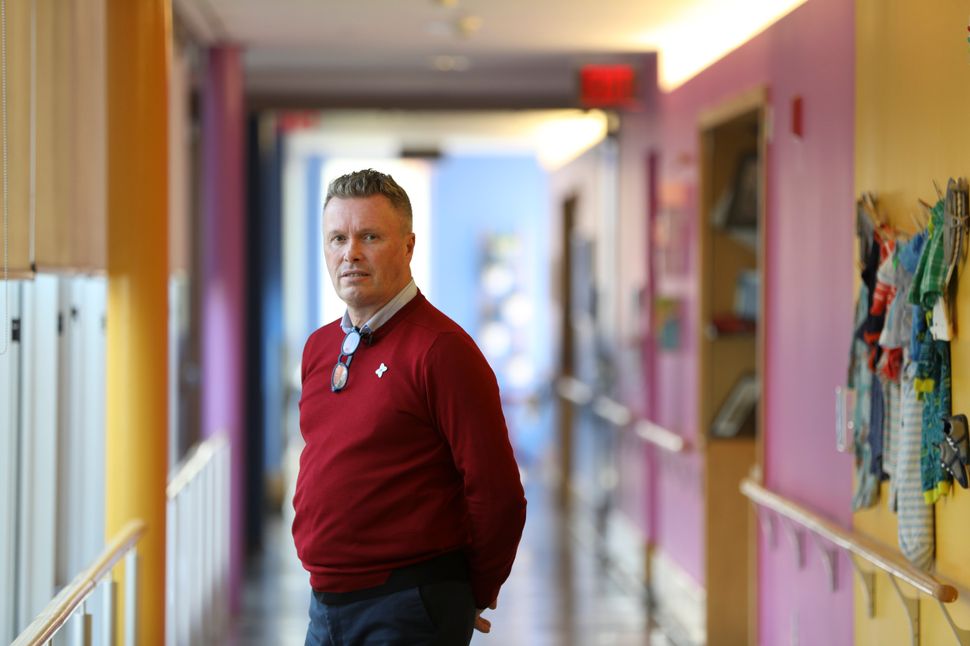
TORONTO — Julie Wheeler expected 2020 to be the year Sunnyside Home adopted a new approach to caring for its residents.
At a public ceremony in January, the home’s administrator announced the Kitchener, Ont. long-term care facility, would adopt the “Butterfly Household Model” of care. Wheeler said the model, which moves a facility away from the traditional medical approach to care, would help fulfill their vision and dream of being a caring community where everyone is at their best.
“I remember speaking and saying how 2020 was a year that we had such a clear vision about where we were going and what we wanted to achieve,” Wheeler told HuffPost Canada. “And then COVID hit.”
The COVID-19 pandemic derailed some of the home’s immediate plans, but Wheeler said it has also strengthened her commitment to the new vision. As Canadians sit inside, watching the world go by from our windows, we are actually experiencing some of the loneliness and purposelessness that residents in long-term care homes felt even before the pandemic hit, she said.

“My hope is that when this is all over, we won’t have to explain or announce why we want to change our model of care,” she said. “It will be understood by everybody how important it is that as humans, we’re connected to one another.”
The Butterfly Model is a specific approach to emotion-based care. It was created by Meaningful Care Matters, a U.K.-based organization that provides the framework and training for culture change programs, as well as consulting on training, development and strategic planning for long-term care homes. Long-term care homes pay to use the Butterfly Model, with a one-year pilot project ending in the organization doing an audit to accredit the home.
Some homes pay to use the Butterfly Model framework from Meaningful Care Matters, while others implement their own similar care approaches that are also based in emotions and relationships, but aren’t specifically part of the “Butterfly” framework.
A few years ago, Sunnyside implemented doll therapy, giving residents the chance to play with, or care for, a baby doll or mechanical pet. Wheeler remembers walking into the dining room one day and seeing a woman who didn’t engage much with staff and was usually slumped over or sleeping in a chair. On this day, she was holding a baby doll as sunlight streamed through the window. It reminded Wheeler of pivotal moments in her own life, like holding her daughters for the first time. “For many of the people that we support, their memories have been left behind, but what is at its highest functioning is their emotions,” she said.

That focus on emotions is at the core of what experts say is a long-overdue culture shift in our long-term care model. The base level of staff needed to bring about cultural changes would also address other issues in long-term care, as well as help homes’ infection control practices, though experts say more funding is needed to make that happen.
Culture change is defined as long-term care facilities processes that shift the focus from tasks that care for a residents’ basic well being and physical health — feeding and bathing, for example — to person-centred care that focuses on their emotions and relationships to improve their quality of life.
Many approaches also involve changes to residents’ physical space, like painting stretches of walls blocks of bright colours. This provides both a happier atmosphere and signals to residents who have dementia and are prone to wandering that they are entering a new area and not trapped in a seemingly endless beige hallway.
Walls also often showcase decorations meant to remind residents of their personal lives, like meaningful clothing, household items or photos. Connections to the outdoor environment are emphasized. Staff are typically allowed to wear everyday clothes instead of scrubs, and hug and touch residents to form bonds. Residents often help with setting the table, or cooking meals.

Many forms of culture change focus on residents with dementia. More than two-thirds of nursing home or long-term care residents had dementia in 2015-16, according to the Canadian Institute for Health Information (CIHI). Seniors who have dementia and live in long-term care “are at higher risk of being physically restrained and given potentially inappropriate antipsychotic drugs than other seniors,” according to the institute. However, policy changes and culture change programs have led to this trend decreasing in recent years, CIHI said.
Long-term care homes have been hard hit by the COVID-19 pandemic. In Ontario as of June 12, there are 63 long-term care homes with a COVID-19 outbreak, and over 1,700 resident deaths.
A whistleblower report from the Canadian Armed Forces detailed disturbing conditions in the five Ontario homes that soldiers were deployed to provide assistance: insect infestations, staff behaving aggressively and inappropriately with residents, and some residents not being fed, bathed, or moved from their beds.
Even before that report came out, provincial inspections of long-term care homes described troubling findings. Advocates and families have long been calling for change. Experts say the end of the pandemic could provide an opportunity to make some of those much-needed changes.
For culture changes to be implemented, other shifts are needed in long-term care.

The COVID-19 pandemic exposed the consequences of homes’ lack of focus on staff well-being, said Sherry Dupuis, a professor at the University of Waterloo’s department of recreation and leisure studies and the co-director of the university’s Partnerships in Dementia Care Alliance.
She is also part of a group that created the philosophy and curriculum of relational caring: a concept that sees relationships between everyone involved in long-term care — residents, staff and family members — as essential to growth and well-being.
Staff, often women of colour, work part time for poverty-level wages and compensate by working in multiple homes. Although the Ontario government has now announced wage increases for front-line workers, a starting wage for personal support workers (PSW) today is $18 an hour, a support worker told HuffPost. Staff can’t provide effective care for residents if they’re struggling themselves, Dupuis said.
They need to be paid a better wage, with benefits, she said. This is an issue that likely contributed to the spread of the virus — staff in Ontario weren’t restricted to working in one home until April 14, after outbreaks had already been declared at some homes. If staff could work full time for a living wage at only one home, it would also help with infection control.
“In order to do that, though, the whole system would have to change ...”
- Sherry Dupuis
Many compassionate staff members want to care for residents differently, but are limited by high resident-to-staff ratios. Workers don’t always have time to give an upset resident a hug, or be present and hold hands to talk for a bit. Dupuis recalls holding a workshop with PSWs where many talked about ways they wanted to support residents with gestures — hugging them, or using a term of endearment, for example. They had to act “under the table” because those words or actions weren’t seen as appropriate. This can cause moral distress and anxiety for staff, she said. When there is more trust among residents and staff, staff say it’s easier for them to provide care.
Dupuis points to a “buddy” program in an Australian long-term care home, where staff were partnered with residents, as one way to support relationships. The pair would do regular activities together to build a relationship, instead of residents seeing different staff members every day. This is called constant or dedicated assignment, where staff get close with residents and their families.
“In order to do that, though, the whole system would have to change … so that staff had full-time jobs, worked in one home and worked with the same residents all the time so you can build those relationships,” Dupuis said.

In February, Ontario launched a study to identify staffing models and the best practices for the training, recruitment and retention of PSWs, nurses, and other care staff. The study, which has continued through the pandemic and is being led by an external group, will inform a “comprehensive staffing strategy to ensure that staffing in long-term care system is sustainable for years to come,” a spokesperson for the Ministry of Long-Term Care told HuffPost by email.
Dupuis also notes that training staff — a big part of introducing a new caring model— takes them away from their jobs. She said that in her experiences going into homes to train staff on relational caring, homes are often unwilling to find replacements for the staff who are at the training, meaning some staff don’t attend it.
David Sheard, founder of the Butterfly Model, has been criticized for not publishing peer-reviewed research on the model in academic journals. Canadian dementia researchers told the CBC that the model needs to be evidence-based to measure its success, instead of relying on stories from families and staff. Sheard, in response, said not publishing academic material on the model was a conscious decision and the personal stories from people involved in the project are more important than scientific evidence.
Workers at Malton Village in Mississauga, Ont., which implemented the Butterfly Model three years ago, have said the home’s pilot project was understaffed. There was not enough funding to hire the extra staff needed to provide the care outlined in the model, workers said in a 2019 CUPE report. Although staff supported the project’s goals, they said delivering the model took a toll on their personal health as it was physically and mentally exhausting.
Jessica Altenor, the home’s administrator, told HuffPost that the home kept its existing staff levels for the start of the pilot and increased those numbers after hearing workers’ feedback. “In order for this to be successful, you really do need more staff to support the people living in the home area,” she said.
Malton Village dealt with a COVID-19 outbreak for six weeks. During that time, the isolation measures posed a challenge to the model of care, but staff were able to care individually for residents, Altenor said. Each resident has a “fiddle box” filled with meaningful items, created by staff and families. These items provided jumping off points for discussions when staff visited with residents.
Toronto Councillor Josh Matlow remembers smiling the first time he walked into one of the home’s Butterfly Model units. One of the first rooms he entered looked like a living room; residents were singing out loud together. Cookies and fruit sat out for residents to take when they were hungry, so they didn’t have to wait for a designated meal time to eat.
His memory of the home is in stark contrast to that of another home, where he walked in and smelled urine and heard screams of frightened residents. “There are long-term care homes in this province that are just horror shows,” Matlow, Toronto’s senior’s advocate, told HuffPost. “This is the moment to change all that.”

The City of Toronto adopted a plan to implement an emotion-centred approach pilot at one of its homes in December 2019. That will hopefully extend to others, Matlow said. The city operates 10 long-term care homes.
He is now calling for Ontario to adopt emotion-centred approaches to care, such as those embodied in the Butterfly Model, into its long-term care act. In an open letter to Premier Doug Ford, Matlow says that emotion-centred care benefits residents through fewer falls, negative response behaviours and less use of antipsychotic drugs. It also saves costs to the health-care system, he wrote.
Matlow calls for an independent inquiry into the province’s long-term care homes. It has committed to a commission — the difference being that an inquiry is separate from the government and has powers to gather information by calling witnesses and gathering documents, neither of which are automatically the case for a commission.
He also wants immediate changes to residents’ quality of care, including increased COVID-19 testing and infection control measures.

The province is “exploring the role of innovative models of care in Ontario’s evolving healthcare landscape,” Ministry of Long-Term Care spokesperson Mark Nesbitt said in an email.
Behaviour Supports Ontario currently provides funding to support staffing resources for person-centred care, as well as equipment and the retention of existing specialized staff, he said.
The province’s own regulations currently prevent some homes from fully implementing new approaches to care, said Laura Tamblyn Watts, the CEO of seniors’ advocacy organization CanAge.
One change that seems small, but is actually very useful for residents who have dementia, is to use softer lighting instead of harsh, institutional lighting, she said. Ontario’s long-term care act regulates what lighting is used, so softer lighting isn’t necessarily an option. “The idea of hyper regulation is that it keeps people safe and well, but in the end it actually creates barriers to innovation and transformation,” she said.
The upfront cost of implementing new approaches can also be a barrier, Tamblyn Watts said, although the financial costs down the line are reduced because of residents’ better health outcomes.
While it’s not impossible to implement these changes in a larger facility, it’s easier in a smaller, village-like setting, she said. Those home-like buildings, with fewer residents in each one, would also make infection control easier since there’s less people in close proximity for a virus to spread.

Cedarhurst Dementia Care Home in Toronto is an example of this. Nestled in a residential area, the home features four living spaces, each with six or seven residents. It is a home only for people who have been diagnosed with dementia. Cedarhurst implemented relational care, based on a curriculum developed by Dupuis and others, a few years ago. Now, personal support workers cook for residents and sit with them while they eat. They sit with residents to watch TV.
“The focus is on nurturing that relationship and on looking for ways throughout your day, that you can do something joyful for a staff member and another resident. It’s a complete culture shift,” Gloria Lattanzio, the CEO of the home, told HuffPost.
“We can only hope that ... there will be changes”
- Gloria Lattanzio
Lattanzio said her staff have developed such a strong sense of camaraderie and teamwork that it has helped carry them through their pandemic response, in addition to their early measures taken to limit staff from working in multiple homes and other preventive measures. The home hasn’t had any COVID-19 cases in staff or residents. One staff member recently told her they feel like focusing on relational caring right now makes their home a light in the darkness of the pandemic.
“Size is an issue, but size is not a barrier,” Lattanzio said of other larger homes considering implementing a relational caring model. She said homes with more residents can start with a small group of residents and expand, noting it’s more important to have committed leadership at the top. She paid for replacement staff to make sure her staff could do the training together as a team.
“What’s happening now is gut-wrenching. And for those of us who have been in the field for decades, this is not new,” Lattanzio said. “We can only hope that right now the spotlight is on this tragic, tragic situation and that there will be changes. [But] whether they’re going to go this far, I don’t know.”

Despite the obvious disruption of the pandemic to her everyday work at Sunnyside Home, not to mention its delaying of the new care model, Wheeler is grateful to have a place other than her home to go to every day where she can fulfill an important role alongside her staff.
“All of these things that seemed like just minute details of our life before, become the focus of what we’ll do when we get out of this,” she said.
“I can’t think of anybody who couldn’t be more motivated than we were before, to make sure that people who live in long-term care have the opportunity to live their best life possible. And maybe we understand now more than we ever did, that living a life where you’re lonely and you’re bored or without purpose is just not living.”